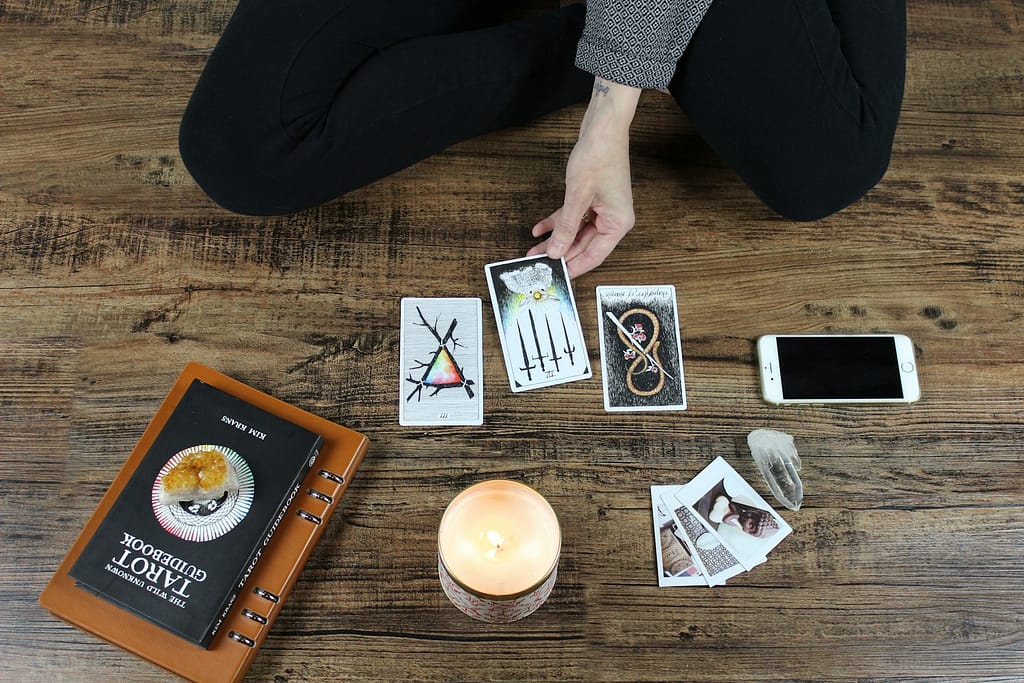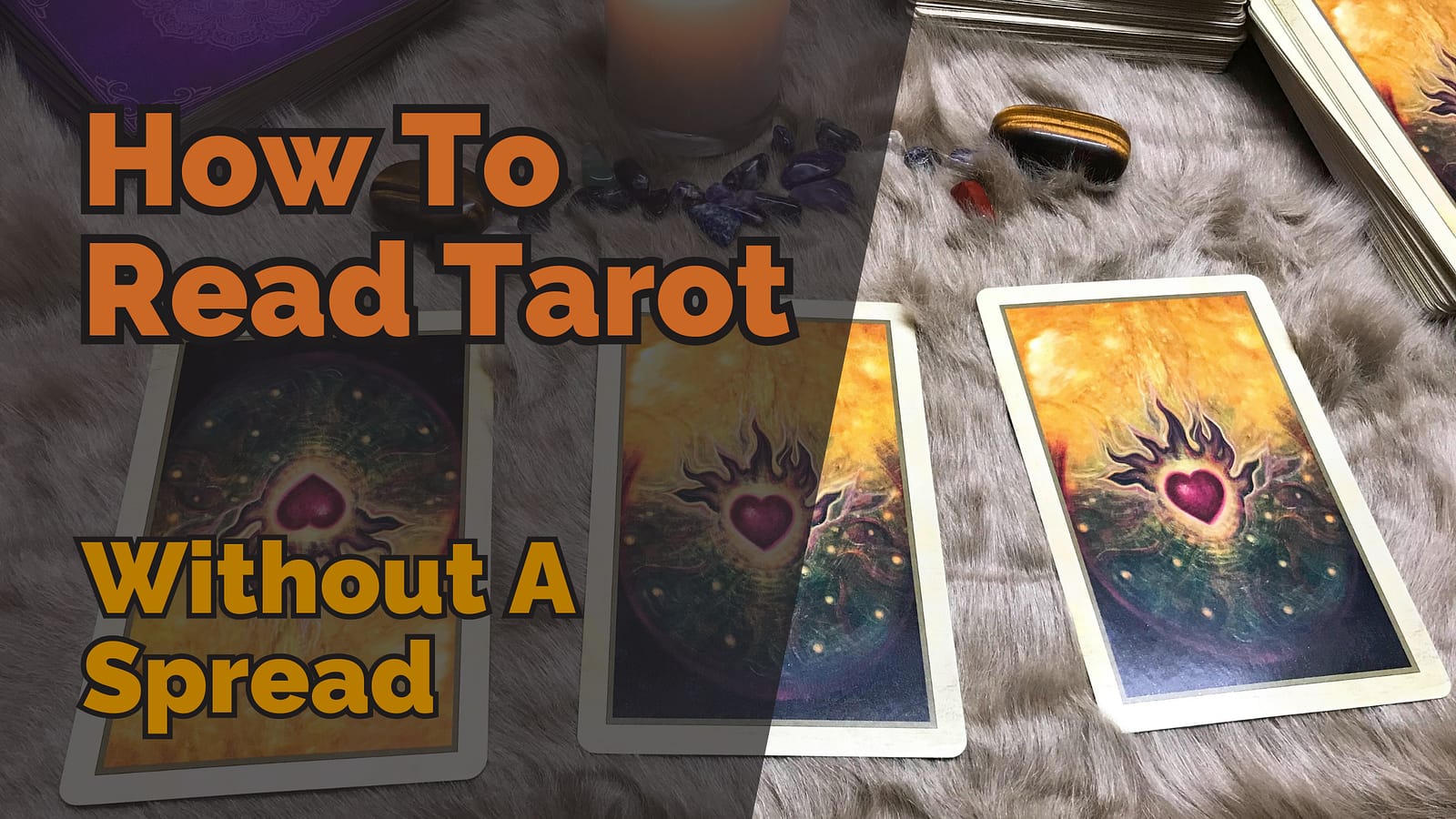
Table of Contents
A tarot journal is one of the most powerful tools you can use to deepen your tarot practice. But people overthink it. You don’t need a fancy setup or hours of free time. It’s just about recording your insights and making them stick.
I’ve used tarot journaling for years; it helped me learn tarot, deepen my readings, and track personal growth. If you’re looking for a free tarot journal PDF, you can grab one by signing up to my mailing list. If you want something structured and printed, I also offer a range of tarot journals on Amazon.
What Is a Tarot Journal?
A tarot journal is simply a place to record readings, card meanings, and personal insights. It’s your own tarot database, where you can keep track of your evolving understanding of the cards and your own intuition. Keeping a tarot journal helps you reflect on your readings over time, notice patterns, and gain deeper insight into what the cards are revealing to you.
Many people find that journaling creates a sense of ritual around tarot, helping them connect more deeply with their readings. Whether you are using it to track daily draws, explore long-term themes, or document specific spreads, a tarot journal serves as an evolving record of your spiritual journey. The more you write, the more personal and meaningful your practice becomes.
Notebook or Sketchbook

A simple notebook or sketchbook is one of the most common ways to keep a tarot journal. Some people prefer lined notebooks for structured notes, while others enjoy blank pages for a more creative approach. A notebook allows you to physically engage with your journal, making it a tangible part of your practice.
Some people like to enhance their journals with drawings, diagrams, or even collage work to make the process more visual. You can paste in printed spreads, use colour coding for themes, or incorporate symbols that hold personal meaning. This can help create a richer and more immersive journaling experience, turning your tarot journal into a work of art as well as a tool for reflection.
Digital Document

A tarot journal doesn’t have to be physical. Many people prefer keeping their tarot records in a digital document, such as a Word file, Google Docs, or note-taking apps like Evernote or Notion. A digital journal has the advantage of being searchable, making it easy to find past readings, track recurring themes, and store large amounts of data without worrying about space.
With digital journaling, you can also integrate multimedia elements. You can upload images of tarot spreads, record voice notes to capture your immediate thoughts, or even create hyperlinked sections to track different topics. If you’re someone who prefers structured organisation and ease of access, a digital tarot journal might be the best option for you.
Structured Tarot Journal
For those who want a bit more guidance, structured tarot journals (like the ones I offer) provide pre-designed prompts and sections to make journaling easier. These journals often include space for writing the date, question, spread used, and card meanings, as well as reflection prompts to help deepen your understanding of the reading.
A structured tarot journal takes the guesswork out of what to include, ensuring consistency in your practice. If you struggle with knowing how to organise your thoughts, a structured approach can help you develop a habit of reflection while giving you the flexibility to personalise your journal as needed.
Why Bother With a Tarot Journal?
Actually Remember Your Readings
Most people forget the details of their tarot readings within days. If you don’t write them down, you might lose valuable insights. A tarot journal gives you a space to document not just the cards you pulled but also how you felt, what your initial impressions were, and what meanings resonated with you at that moment.
Over time, you can look back at old readings and see how your interpretations have evolved. Sometimes a card might not make sense in the moment, but revisiting it later can provide clarity. This ability to reflect and reassess adds depth to your practice and allows you to engage with the cards on a much deeper level.
Learn Tarot Faster

One of the best ways to get better at reading tarot is by writing down your interpretations of each card. By recording what a card meant in a particular reading, you start building a personal reference library. Instead of memorizing card meanings from a guidebook, you develop your own intuitive understanding, making your readings feel more personal and accurate.
Journaling also helps reinforce your learning. The more you actively engage with the cards, the more their meanings become second nature to you. You might start noticing connections between different cards, recurring themes in certain spreads, or even unique personal associations that deepen your relationship with the deck.
If you’re looking for a structured way to deepen your understanding of the cards, my Simply Tarot Journal is designed to help you develop your own meanings while learning tarot. This journal provides dedicated space to record insights for each card, track recurring themes in your readings, and reflect on how different cards interact with one another. Rather than relying solely on traditional definitions, it encourages you to explore tarot in a way that feels personal and intuitive.
Whether you’re just starting out or refining your practice, using a guided tarot journal like this can accelerate your learning and help you form a stronger connection with the deck.
Notice Patterns Over Time
Tarot is all about patterns: certain themes, symbols, or messages tend to repeat. By keeping a journal, you can track these patterns and see what they might be telling you. Do you keep pulling The High Priestess when struggling with self-trust? Is The Tower showing up during times of major change?
Recognising these patterns can help you understand what the tarot is revealing about your personal cycles. It also allows you to prepare for challenges ahead or recognise lessons you might not have noticed otherwise. A tarot journal becomes an invaluable tool for seeing the bigger picture in your readings.
Turn Insights into Action
A tarot reading is pointless if you don’t apply what you learn. Your journal can be a tool for self-improvement. If a reading suggests you need to let go of something toxic in your life, journaling can help you brainstorm steps to make that happen.
If a spread highlights a need for self-care, you can outline small changes to support your well-being. Writing things down makes them feel more concrete, increasing the likelihood that you’ll follow through. Journaling ensures you don’t just reflect on your readings but actually do something with them.
How I Use Tarot Journaling (And Why I Encourage It)
I’ve been using a tarot journal for years, and I always encourage my clients to do the same. It’s been one of the most valuable tools in deepening my tarot practice, not just for learning the cards but for processing insights from readings and tracking patterns over time. The act of journaling makes readings more tangible, it keeps you from forgetting important details and gives you something to return to when you need perspective.
Because I believe so strongly in the value of tarot journaling, every premium tarot reading I offer comes with a personalised tarot journal. This isn’t just a blank notebook; it’s a fully structured reflection tool designed to help you get the most out of your reading.
What’s Included in My Personalised Tarot Journals?
When you book a premium tarot reading with me, you receive a digital tarot journal tailored to your reading. This includes:
- A breakdown of the tarot spread used – So you can remember the structure of the reading and what each position represented.
- A picture of the cards drawn – A visual reference so you can reflect on the imagery long after the reading.
- A summary of my insights – My interpretations of each card and how they connect to your situation.
- Space for your own reflections – Because the reading doesn’t end when the session is over. You can write down how the messages resonate, how they evolve over time, and any action steps you want to take.
Why This Matters
A lot of people walk away from a tarot reading feeling inspired, but then life happens, and they forget most of what was said. Having a structured tarot journal means you can revisit the reading days, weeks, or even months later to see how the guidance unfolds. It helps you stay connected to the insights that came up in the session and encourages deeper self-reflection.
If you want a fully guided tarot journaling experience, book a premium tarot reading with me, and you’ll receive a personalised digital journal to help you integrate and reflect on your reading.
How to Start a Tarot Journal (Without Overcomplicating It)
Starting a tarot journal can feel overwhelming at first, but the key is to keep it simple. You don’t need to write a novel for every reading; you just need a system that works for you. Here are a few expanded ideas on how to set up your tarot journal.
Setting Up Your Tarot Journal

First, decide on the format that works best for you, paper or digital. If you’re someone who enjoys the ritual of writing things by hand, a physical notebook might be best. If you prefer something searchable and easy to organise, a digital tarot journal in an app like Notion or GoodNotes might work better. There’s no right or wrong way, just choose something you’ll actually use consistently.
Once you’ve chosen your format, consider creating sections in your journal. Some people like to dedicate different pages for daily card pulls, in-depth readings, and personal card meanings. Others prefer to keep everything in chronological order. Experiment and see what works for you.
How to Structure a Tarot Journal Entry
Every tarot journal entry should include the following elements:
Date & Question Asked
This might seem like a small detail, but writing down the date and your question is essential. It gives context to your reading and helps you track themes over time. If you’re doing a general daily pull, simply note the intention for the reading (e.g., “What energy should I focus on today?”).
List of the Cards Drawn
Write down each card you pulled and whether they were upright or reversed. If you’re using a specific spread, note which position each card was in. This ensures that when you revisit the reading later, you’ll remember the structure of the spread and how each card fits into it.
Your First Impressions
Before reaching for a guidebook, take a moment to write down your initial gut reactions. What stands out in the imagery? What emotions come up? Do any symbols jump out at you? This helps you develop a more intuitive relationship with the cards rather than relying on pre-written meanings.
Key Insights & Interpretation
After noting your first impressions, go deeper into the meaning of each card. If you use a tarot guidebook, compare its interpretations with your own. How does the message of the reading apply to your situation? Does it bring up any important reflections or decisions you need to make?
Actionable Steps
A tarot reading should lead to insight, but insight alone isn’t enough; it needs to be followed by action. Write down any steps you want to take based on what came up in the reading. This could be something as simple as a mindset shift or as concrete as having a difficult conversation with someone in your life. Setting clear actions helps turn tarot into a tool for transformation.
What to Do With Your Tarot Journal Over Time
Once you’ve been keeping a tarot journal for a while, it’s important to use it as more than just a record-keeping tool. Your journal should also be a resource for self-reflection and growth. Here’s how to make the most of it:
Revisiting Past Readings

Go back and read old journal entries every few months to see how things have developed. Do any past readings make more sense in hindsight? Did certain predictions or themes unfold the way you expected? Taking the time to reflect on old readings can provide a powerful perspective on your personal journey.
Looking for Repeating Cards & Themes
Certain cards tend to show up repeatedly in our readings, often because they carry messages we need to hear. If you keep pulling the same card over and over, take time to dedicate an entry to exploring its meaning in different contexts. What is this card trying to tell you? How does its message evolve over time?
Using Your Journal for Goal Setting
Tarot isn’t just about self-reflection; it can also be a tool for manifestation and personal growth. If a reading suggests that you need to work on confidence, set specific goals around that. If a spread indicates you need to let go of something, write down ways to take action. Your journal can become a roadmap for transformation.
Incorporating Additional Reflections
You don’t have to limit your tarot journal to just readings. You can use it to explore dreams, synchronicities, or spiritual insights that arise in daily life. Keeping a dedicated section for these moments can help you see how your tarot practice connects to your broader life experience.
Paper vs. Digital Tarot Journals
Paper Tarot Journals
A physical tarot journal can feel deeply personal and immersive. Writing by hand encourages you to slow down and process your thoughts more deliberately. Many people find the tactile experience of flipping through pages, underlining key phrases, or sketching symbols adds an extra layer of meaning to their practice.
However, paper journals have limitations. They take up physical space, and once a notebook is full, it can be challenging to organise old readings. Searching for past entries can also be time-consuming unless you use a detailed indexing system.
Digital Tarot Journals
A digital tarot journal offers the advantage of easy organisation. You can tag entries, search for keywords, and back up your reflections for safekeeping. Digital journals also allow for multimedia elements; you can include pictures of your spreads, voice notes of your immediate impressions, or even hyperlinks to articles that resonate with your reading.
Some people find digital journaling less engaging, as typing doesn’t feel as personal as handwriting. However, if you prefer a structured approach and want to access your tarot journal from anywhere, a digital format can be incredibly convenient.
Which One is Right for You?
There’s no right or wrong choice; it depends on your personal preference. Some people even combine both methods, using a paper journal for deep reflections and a digital one for quick notes and searches. Experiment with both and see what works best for you.
Conclusion: Tarot Journaling Doesn’t Have to Be Hard
Keeping a tarot journal isn’t about being perfect; it’s about making sure you don’t lose the insights you gain from your readings. Whether you prefer digital or physical journaling, the important thing is to actually do it.
If you want a free tarot journal PDF, sign up for my mailing list. If you’d prefer a structured printed tarot journal, check out my tarot journals on Amazon.
For a fully personalised tarot journaling experience, book a premium tarot reading with me. Each session comes with a tailored digital reflection journal, including a breakdown of the spread, my insights, and space for your own reflections, so you can revisit the guidance whenever you need it.
Start journaling today and watch your tarot practice transform!
Take Your Tarot Insights Further
Ready to dive deeper into your reading? Download my free Reflection Journal to help you process, reflect, and integrate the guidance you’ve received.
This journal includes:
- Space to jot down key messages from your reading
- Guided prompts to uncover deeper insights
- A framework to set meaningful, actionable goals
Simply enter your name and email below to grab your copy and take the next step on your journey.
By signing up to receive the free reflection journal, you’ll also be added to my mailing list. You can unsubscribe anytime.





